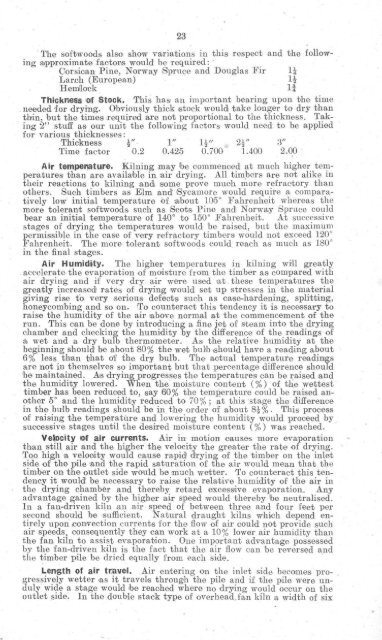Download Full PDF - 19.3 MB - The Society of Irish Foresters
Download Full PDF - 19.3 MB - The Society of Irish Foresters
Download Full PDF - 19.3 MB - The Society of Irish Foresters
Create successful ePaper yourself
Turn your PDF publications into a flip-book with our unique Google optimized e-Paper software.
23<br />
'I.'he s<strong>of</strong>twoods, alsO' show va.riations in this respect and the following<br />
rupproximate factorrs would' be required:<br />
Corsican Pine, Norway Spruce and Douglas Fir Ii<br />
Lamh (Europe'a.n) I!<br />
Remaoek<br />
Ii<br />
ThiicknelSSi '00 Stock. This has an important bearing upon the time<br />
. needed -for drying. Obviously thick ,stock would take longer to dry than<br />
th~n, but the times required are not prOlportional to the thickness. Takillg<br />
2" stuff as our unit the following factors would need to be applied<br />
for various thicknesses:<br />
Thickness 1". 1"<br />
] .1.'1<br />
2!" 3"<br />
Time factor • 0.2 0.425 0.700 1.400 2.00<br />
Air tempe'1a,ture. Kilning may Ihe commenced at much higher tempera.tures<br />
than are availa'ble in. ,air drying. All tim,bers are not rulike in<br />
their reactions to kilning and some prove much more refrac'1.o,ry than<br />
others. Such timbers as Elm and: Sycamore would require a comparatively<br />
low initial temperature <strong>of</strong> about 105' Fahrenheit whereas the<br />
more tolerant s'<strong>of</strong>twoods such as Scots Pine and! Norway Spruce could<br />
bear an initial temperature <strong>of</strong> 140' to 150' Fahrenheit. At succcssive<br />
stages <strong>of</strong> drying the temperatures' would be raised, but the maximunl<br />
permissible in the case <strong>of</strong> very refractory timbe,r s wonld not exceed 120'<br />
Fahrenheit. 'I.'he more tolerant s<strong>of</strong>twoods could reach as much as 180'<br />
in the final stages.<br />
Air Humidity. <strong>The</strong> higher temperatures in kilning wiU greatly<br />
accelerate the evaporation <strong>of</strong> moisture from the timber as comllared with<br />
air drying and if very dry air were used 'at these temperatur€s the<br />
greatly increased! rates <strong>of</strong> drying would: set up stresses in the material<br />
giving rise to very ·serious defects such as cruse-hardening, splitting,<br />
honeycombing and so on. fro counteract this tendency it is neceSiSaTY to<br />
ra;ise the humidity <strong>of</strong> the air ,above normal at the commencement <strong>of</strong> the<br />
run. This oon be done by introdu.cing a fine jet <strong>of</strong> steam into the drying<br />
chamber and checking the humidity by the difference <strong>of</strong> the readings <strong>of</strong><br />
a· wet and a dry bulb thermometer. As the relative humidity at the<br />
beginning should he about 80% the wet bullb .should have a reading about<br />
6% less than that <strong>of</strong> the dry bulb. <strong>The</strong> actual temperature readirugs<br />
are not in themselves so im.portant but that percentage difference should<br />
'be maintained. Als drying progresses the temperatures can be raised ,and<br />
the humidity lowered. When the moisture content (%) <strong>of</strong> tlie wettest<br />
timber has been reduced to, ·say 60% the temperature could be raised another<br />
5' and the humidity reduced to 70% ;at this stage the difference<br />
in the buIb readings should be in the order <strong>of</strong> about 8t%. This process<br />
<strong>of</strong> rais'ing the temperature and lowering the humidity would proceed by .<br />
successive stages until the desired moisture content (%) was reached.<br />
Ve~ocity IOf air currents. Air in motion causes mo.re evaporation<br />
than still air and the higher the velocity the greater .the rate <strong>of</strong> drying.<br />
'foo high 'a velocity would cause rapid! drying ·<strong>of</strong> the timber on the inlet<br />
s!de -<strong>of</strong> the pile 'and t~e rapid saturation <strong>of</strong> the air would mean th~t the<br />
timber on the -outlet SIde would be much wetter. To counteract thIS tendency<br />
it would be necessal'Y to l'aise the relative humidity <strong>of</strong> the air in<br />
the drying chamber and thereby retard excessive evaporation. Any<br />
advantage gained by the higher a.i.r speed would thereby be neutralised.<br />
In a fan-driven kiln call air speed <strong>of</strong> between three and four feet per<br />
second should be sufficient. Natural draught kilns whi.ch depend entirely<br />
upon convection currents for the flow <strong>of</strong> air could not provide such<br />
aIrspeeds, consequently they can work at a 10% lower air humidity than<br />
the fan kiln to assist evaporation. One important advantage possessed<br />
by the fan-driven kiln is the fact that the air flow can be reversed and<br />
the timber pile be dried equally from each side.<br />
Lm,gth <strong>of</strong> air travel. Air entering on the inlet side becomes progressively<br />
wetter ,as it traveLs through the pile and if the pile were unduly<br />
wi~e a stage would 'be reached where no drying would occur on the<br />
outlet SIde. In the douhle st!l!ck type <strong>of</strong> overhead fan kiln a width <strong>of</strong> six

















